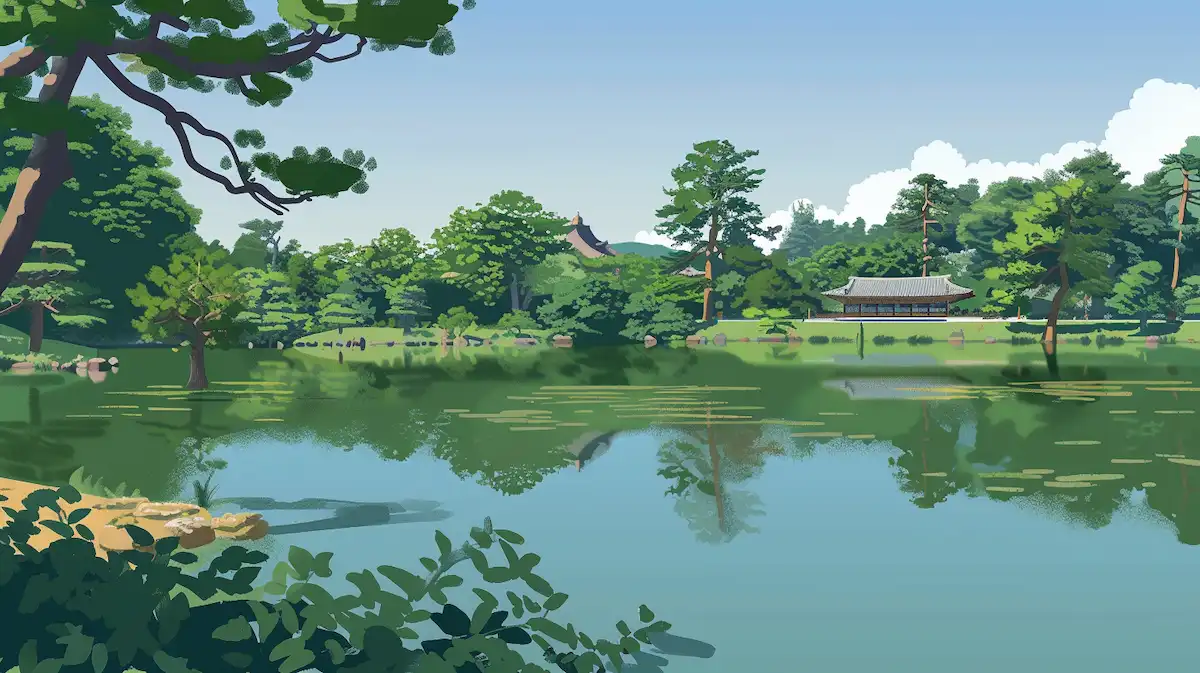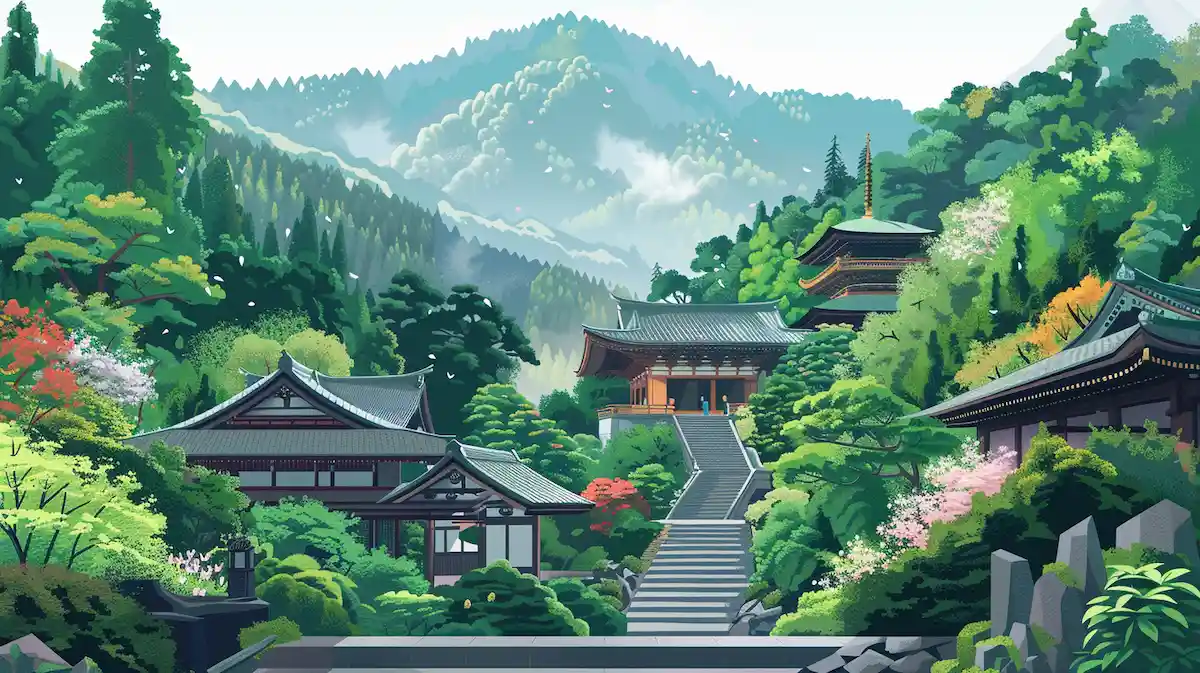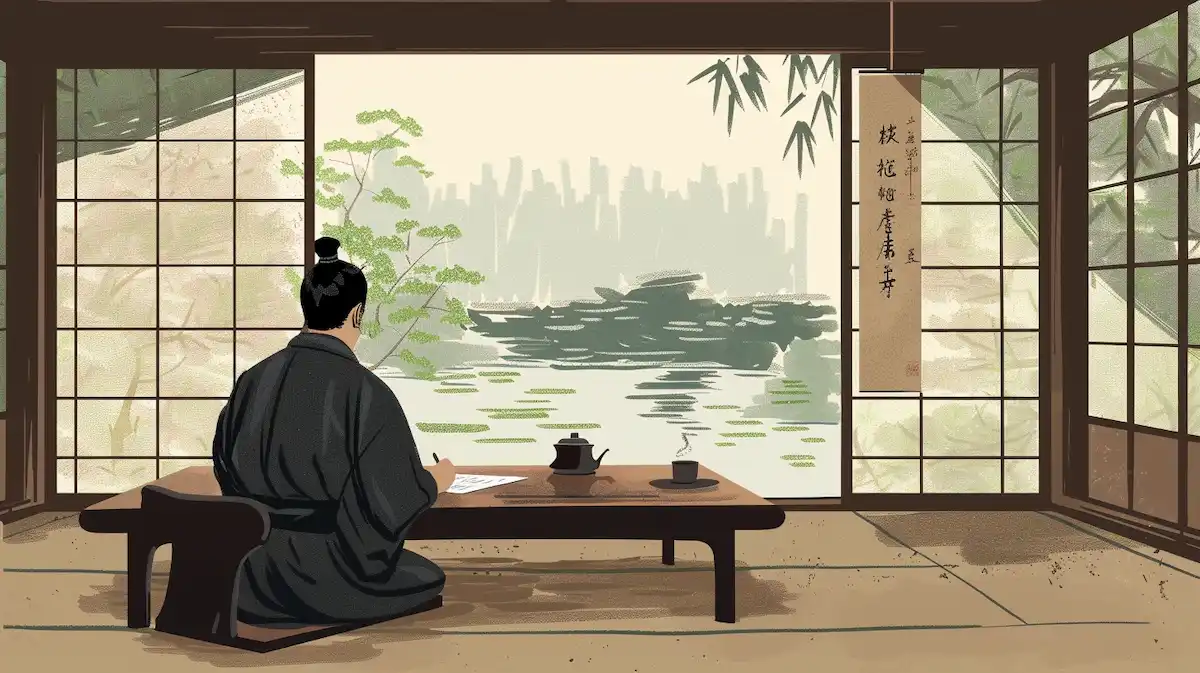松尾芭蕉を英語で説明・紹介するための基本情報と、英会話に役立つ表現をシンプルでわかりやすい英語で紹介します。
英会話ダイアローグ・概要・10の質問・詳細情報を通して、松尾芭蕉に関する英語表現を学びます。
英語
英会話ダイアローグを読む前に知っておくと良い前提知識と情報は以下の通りです。
- 松尾芭蕉の生涯
- 松尾芭蕉(1644年 – 1694年)は、江戸時代初期の俳人。本名は松尾宗房(まつお むねふさ)で、伊賀国(現在の三重県伊賀市)で生まれました。多くの俳句を残しました。
- 俳句とは
- 俳句は、5-7-5の17音で構成される短い詩です。自然や季節の美しさを表現することが多いです。芭蕉はこの俳句を重要な芸術形式として広めました。
- おくのほそ道
- 『おくのほそ道』は芭蕉が1689年に弟子の曽良と共に行った東北・北陸地方の旅行記です。この旅行記には彼が旅の途中で詠んだ多くの俳句が含まれています。例えば、「夏草や 兵どもが 夢の跡」などが有名です。
- わび・さびの美学
- わび・さびは、日本独特の美意識で、シンプルさや不完全さ、古びたものの中に美しさを見出す考え方です。芭蕉の作品には、このわび・さびの精神が色濃く反映されています。
2人が有名な俳人である松尾芭蕉について話しています。
芭蕉の生涯、俳句、「おくのほそ道」といった作品や旅の目的、訪れた場所、そして芭蕉の美意識である「わび・さび」などを話題にしています。
会話 / dialogue

Hey Key, I’ve been really interested in Matsuo Basho lately. Do you know much about him?

Yes, I do! Basho is one of Japan’s most famous poets. He lived during the early Edo period, around the 17th century.

I read that he wrote haiku. What exactly is haiku?

Haiku is a type of short poem with 17 syllables, usually in a 5-7-5 pattern. Basho made haiku very popular and respected. His poems often focus on nature and the simple, yet deep moments in life.

That sounds fascinating. How did he become so famous?

Basho was born in Iga Province, now Mie Prefecture. His real name was Matsuo Munefusa. He moved to Edo, which is now Tokyo, in 1675 to focus on writing haiku seriously. His work captured the beauty of nature and the emotions of life.

I heard about his travel diary, “Oku no Hosomichi.” What’s special about it?

“Oku no Hosomichi,” or “The Narrow Road to the Deep North,” is a famous travel diary. In 1689, Basho traveled with his student Sora through the Tohoku and Hokuriku regions. He wrote about his experiences and the places he visited, including many beautiful haiku.

Can you share one of his famous haiku?

Sure. One of his most famous haiku is:
Old pond
Frog jumps in
Sound of water

Wow, that’s simple but powerful. What else makes Basho so special?

Basho’s ability to capture the essence of nature and human emotions in very few words is remarkable. He made haiku an important art form and inspired many poets. He also had a spiritual aspect to his travels and writing.

Did he visit any famous places during his travels?

Yes, he did. For example, he visited Hiraizumi, Matsushima, and Yamadera. Each place inspired beautiful haiku. His travels were both a search for inspiration and a spiritual journey.

I would love to visit those places and see what inspired him. Do you have any other interesting facts about him?

Basho valued simplicity and imperfection, a concept known as “wabi-sabi.” He saw beauty in the old and worn, like a cracked teacup or an ancient tree.

That’s really interesting. His life and work seem so deep and meaningful. I want to learn more about him and maybe even write some haiku myself.

That sounds like a great idea, Mack. Studying Basho’s work can give you a lot of insight into Japanese culture and poetry.
概要 / Overview
「松尾芭蕉」について、理解を深めるための「英語での概要」です。
松尾芭蕉

Who was Matsuo Basho?
Matsuo Basho (1644 – 1694) was a famous Japanese poet during the early Edo period. His real name was Matsuo Munefusa. He is best known for his haiku poetry, which are short poems with 17 syllables in a 5-7-5 pattern. Basho’s poems often focus on nature and the simple moments in life.
Early Life and Career
Basho was born in Iga Province, which is now Mie Prefecture. As a young man, he moved to Edo, now Tokyo, in 1675 to study and write haiku seriously. He learned haiku from a teacher named Kitamura Kigin. Basho’s haiku captured the beauty of nature and the emotions of life, making haiku a respected art form.
Oku no Hosomichi
In 1689, Basho went on a long journey with his student Sora. They traveled through the Tohoku and Hokuriku regions of Japan. Basho wrote a travel diary called “Oku no Hosomichi” (The Narrow Road to the Deep North). This diary includes many of his haiku, like the famous one about the summer grass and the dreams of soldiers. This journey was both for inspiration and spiritual reflection.
Wabi-Sabi
Basho’s work often reflects the Japanese aesthetic of wabi-sabi, which finds beauty in simplicity, imperfection, and old things. He saw beauty in things like a cracked teacup or an old tree. This concept is important in understanding Basho’s poetry and his view of the world.
10の質問 / 10 questions
「松尾芭蕉」について、理解を深めるための「英語での10の質問」です。
1: Who was Matsuo Basho?
Matsuo Basho was a famous Japanese poet from the Edo period. He is best known for his haiku, a short form of Japanese poetry.
2: What is haiku?
Haiku is a traditional Japanese poem with 17 syllables, usually in a 5-7-5 pattern. It often focuses on nature and the seasons.
3: Why is Matsuo Basho important in Japanese literature?
Matsuo Basho is important because he popularized haiku and elevated it to a respected art form. His work is still admired today for its simplicity and depth.
4: What is “Oku no Hosomichi”?
“Oku no Hosomichi” (The Narrow Road to the Deep North) is a travel diary written by Matsuo Basho. It details his journey through northern Japan and includes many of his haiku.
5: What inspired Matsuo Basho’s poetry?
Basho was inspired by nature, his travels, and the concept of “wabi-sabi,” which finds beauty in simplicity and imperfection.
6: What is one of Matsuo Basho’s most famous haiku?
One of his most famous haiku is:
“Old pond,
A frog jumps in,
Sound of water.”
7: What is the concept of “wabi-sabi”?
“Wabi-sabi” is a Japanese aesthetic that finds beauty in simplicity, imperfection, and the natural aging process.
8: Where did Matsuo Basho travel in “Oku no Hosomichi”?
In “Oku no Hosomichi,” Basho traveled through the Tohoku and Hokuriku regions of Japan, visiting places like Hiraizumi, Matsushima, and Yamadera.
9: How did Matsuo Basho influence other poets?
Basho influenced many poets by showing that haiku could express deep emotions and complex ideas in very few words. His style continues to inspire poets today.
10: What is the significance of Matsuo Basho’s work today?
Matsuo Basho’s work remains significant because it captures the timeless beauty of nature and human experiences, making his poetry relevant even in modern times.
和訳付
会話 / dialogue

Hey Key, I’ve been really interested in Matsuo Basho lately. Do you know much about him?
ねえキー、最近松尾芭蕉にすごく興味があるんだ。彼のこと、よく知ってる?

Yes, I do! Basho is one of Japan’s most famous poets. He lived during the early Edo period, around the 17th century.
うん、知ってるよ!芭蕉は日本で最も有名な詩人の一人なんだ。彼は江戸時代初期、17世紀頃に生きてたんだ。

I read that he wrote haiku. What exactly is haiku?
彼が俳句を書いたって読んだよ。俳句って具体的に何?

Haiku is a type of short poem with 17 syllables, usually in a 5-7-5 pattern. Basho made haiku very popular and respected. His poems often focus on nature and the simple, yet deep moments in life.
俳句は17音からなる短い詩で、通常は5-7-5のパターンだよ。芭蕉が俳句をとても人気で尊敬されるものにしたんだ。彼の詩は自然やシンプルだけど深い瞬間に焦点を当てていることが多いんだ。

That sounds fascinating. How did he become so famous?
それは面白そうだね。彼はどうやってそんなに有名になったの?

Basho was born in Iga Province, now Mie Prefecture. His real name was Matsuo Munefusa. He moved to Edo, which is now Tokyo, in 1675 to focus on writing haiku seriously. His work captured the beauty of nature and the emotions of life.
芭蕉は伊賀国、今の三重県で生まれたんだ。本名は松尾宗房。1675年に俳句を書くことに専念するために江戸、今の東京に引っ越したんだ。彼の作品は自然の美しさや人生の感情を捉えているんだ。

I heard about his travel diary, “Oku no Hosomichi.” What’s special about it?
彼の旅行記「おくのほそ道」について聞いたことがあるよ。何が特別なの?

“Oku no Hosomichi,” or “The Narrow Road to the Deep North,” is a famous travel diary. In 1689, Basho traveled with his student Sora through the Tohoku and Hokuriku regions. He wrote about his experiences and the places he visited, including many beautiful haiku.
「おくのほそ道」は有名な旅行記なんだ。1689年に芭蕉は弟子の曽良と一緒に東北と北陸を旅したんだ。彼は自分の体験や訪れた場所について書き、その中には多くの美しい俳句も含まれているんだ。

Can you share one of his famous haiku?
彼の有名な俳句の一つを教えてくれる?

Sure. One of his most famous haiku is:
Old pond
Frog jumps in
Sound of water
もちろん。彼の最も有名な俳句の一つはこれだよ:
古池や
蛙飛びこむ
水の音

Wow, that’s simple but powerful. What else makes Basho so special?
わあ、シンプルだけど力強いね。芭蕉の他の特別なところは何?

Basho’s ability to capture the essence of nature and human emotions in very few words is remarkable. He made haiku an important art form and inspired many poets. He also had a spiritual aspect to his travels and writing.
芭蕉は少ない言葉で自然や人間の感情の本質を捉える能力がすごいんだ。彼は俳句を重要な芸術形式にし、多くの詩人に影響を与えたんだ。彼の旅や執筆には精神的な側面もあったんだよ。

Did he visit any famous places during his travels?
彼は旅の途中で有名な場所を訪れたの?

Yes, he did. For example, he visited Hiraizumi, Matsushima, and Yamadera. Each place inspired beautiful haiku. His travels were both a search for inspiration and a spiritual journey.
うん、訪れたよ。例えば、平泉、松島、山寺に行ったんだ。それぞれの場所で美しい俳句を詠んでいるんだ。彼の旅はインスピレーションを求めると同時に精神的な旅でもあったんだ。

I would love to visit those places and see what inspired him. Do you have any other interesting facts about him?
僕もその場所を訪れて、彼にインスピレーションを与えたものを見てみたいな。他に面白い事実はある?

Basho valued simplicity and imperfection, a concept known as “wabi-sabi.” He saw beauty in the old and worn, like a cracked teacup or an ancient tree.
芭蕉は「わび・さび」という、シンプルさや不完全さを重視したんだ。ひび割れた茶碗や古い木のような古びたものに美しさを見出していたんだよ。

That’s really interesting. His life and work seem so deep and meaningful. I want to learn more about him and maybe even write some haiku myself.
それは本当に興味深いね。彼の人生と作品はとても深くて意味があるように思える。もっと彼のことを学んで、もしかしたら自分でも俳句を書いてみたいな。

That sounds like a great idea, Mack. Studying Basho’s work can give you a lot of insight into Japanese culture and poetry.
それはいいアイデアだね、マック。芭蕉の作品を学ぶことで、日本の文化や詩について多くの洞察を得られるよ。
概要 / Overview
松尾芭蕉

Who was Matsuo Basho?
Matsuo Basho (1644 – 1694) was a famous Japanese poet during the early Edo period. His real name was Matsuo Munefusa. He is best known for his haiku poetry, which are short poems with 17 syllables in a 5-7-5 pattern. Basho’s poems often focus on nature and the simple moments in life.
松尾芭蕉とは?
松尾芭蕉(1644年 – 1694年)は、江戸時代初期の有名な日本の詩人です。本名は松尾宗房(まつお むねふさ)です。彼は17音の5-7-5パターンの短い詩である俳句で最もよく知られています。芭蕉の詩は自然やシンプルな瞬間に焦点を当てることが多いです。
Early Life and Career
Basho was born in Iga Province, which is now Mie Prefecture. As a young man, he moved to Edo, now Tokyo, in 1675 to study and write haiku seriously. He learned haiku from a teacher named Kitamura Kigin. Basho’s haiku captured the beauty of nature and the emotions of life, making haiku a respected art form.
初期の人生とキャリア
芭蕉は伊賀国(現在の三重県)で生まれました。若い頃、1675年に俳句を真剣に学び書くために江戸(現在の東京)に引っ越しました。彼は北村季吟という教師から俳句を学びました。芭蕉の俳句は自然の美しさや人生の感情を捉え、俳句を尊敬される芸術形式にしました。
Oku no Hosomichi
In 1689, Basho went on a long journey with his student Sora. They traveled through the Tohoku and Hokuriku regions of Japan. Basho wrote a travel diary called “Oku no Hosomichi” (The Narrow Road to the Deep North). This diary includes many of his haiku, like the famous one about the summer grass and the dreams of soldiers. This journey was both for inspiration and spiritual reflection.
おくのほそ道
1689年、芭蕉は弟子の曽良と一緒に長い旅に出ました。彼らは日本の東北地方と北陸地方を旅しました。芭蕉は「おくのほそ道」という旅行記を書きました。この日記には「夏草や兵どもが夢の跡」のような彼の有名な俳句が多く含まれています。この旅はインスピレーションと精神的な反省のためでした。
Wabi-Sabi
Basho’s work often reflects the Japanese aesthetic of wabi-sabi, which finds beauty in simplicity, imperfection, and old things. He saw beauty in things like a cracked teacup or an old tree. This concept is important in understanding Basho’s poetry and his view of the world.
わび・さび
芭蕉の作品は、シンプルさ、不完全さ、古いものの中に美を見出す日本の美学「わび・さび」を反映していることが多いです。彼はひび割れた茶碗や古い木のようなものに美を見出しました。この概念は芭蕉の詩と彼の世界観を理解する上で重要です。
10の質問 / 10 questions
1: Who was Matsuo Basho?
松尾芭蕉とは誰ですか?
Matsuo Basho was a famous Japanese poet from the Edo period. He is best known for his haiku, a short form of Japanese poetry.
松尾芭蕉は江戸時代の有名な日本の詩人です。彼は短い形式の詩である俳句で最もよく知られています。
2: What is haiku?
俳句とは何ですか?
Haiku is a traditional Japanese poem with 17 syllables, usually in a 5-7-5 pattern. It often focuses on nature and the seasons.
俳句は、通常5-7-5のパターンで17音からなる日本の伝統的な詩です。自然や季節に焦点を当てることが多いです。
3: Why is Matsuo Basho important in Japanese literature?
松尾芭蕉はなぜ日本文学において重要ですか?
Matsuo Basho is important because he popularized haiku and elevated it to a respected art form. His work is still admired today for its simplicity and depth.
松尾芭蕉は俳句を普及させ、尊敬される芸術形式に高めたため重要です。彼の作品はそのシンプルさと深さで今日でも称賛されています。
4: What is "Oku no Hosomichi"?
「おくのほそ道」とは何ですか?
"Oku no Hosomichi" (The Narrow Road to the Deep North) is a travel diary written by Matsuo Basho. It details his journey through northern Japan and includes many of his haiku.
「おくのほそ道」は松尾芭蕉が書いた旅行記です。日本の北部を旅した詳細が記され、多くの俳句が含まれています。
5: What inspired Matsuo Basho’s poetry?
松尾芭蕉の詩は何に影響を受けましたか?
Basho was inspired by nature, his travels, and the concept of "wabi-sabi," which finds beauty in simplicity and imperfection.
芭蕉は自然、彼の旅、そしてシンプルさと不完全さに美を見出す「わび・さび」の概念に影響を受けました。
6: What is one of Matsuo Basho's most famous haiku?
松尾芭蕉の最も有名な俳句の一つは何ですか?
One of his most famous haiku is:
"Old pond,
A frog jumps in,
Sound of water."
彼の最も有名な俳句の一つは次の通りです:
「古池や、蛙飛びこむ、水の音」
7: What is the concept of "wabi-sabi"?
「わび・さび」とはどんな概念ですか?
"Wabi-sabi" is a Japanese aesthetic that finds beauty in simplicity, imperfection, and the natural aging process.
「わび・さび」は、シンプルさ、不完全さ、自然の老化過程に美を見出す日本の美学です。
8: Where did Matsuo Basho travel in "Oku no Hosomichi"?
「おくのほそ道」で松尾芭蕉はどこを旅しましたか?
In "Oku no Hosomichi," Basho traveled through the Tohoku and Hokuriku regions of Japan, visiting places like Hiraizumi, Matsushima, and Yamadera.
「おくのほそ道」で芭蕉は東北地方と北陸地方を旅し、平泉や松島、山寺などを訪れました。
9: How did Matsuo Basho influence other poets?
松尾芭蕉は他の詩人にどのように影響を与えましたか?
Basho influenced many poets by showing that haiku could express deep emotions and complex ideas in very few words. His style continues to inspire poets today.
芭蕉は、俳句が非常に少ない言葉で深い感情や複雑な考えを表現できることを示し、多くの詩人に影響を与えました。彼のスタイルは今日でも詩人を刺激し続けています。
10: What is the significance of Matsuo Basho's work today?
今日の松尾芭蕉の作品の重要性は何ですか?
Matsuo Basho's work remains significant because it captures the timeless beauty of nature and human experiences, making his poetry relevant even in modern times.
松尾芭蕉の作品は、自然の永遠の美しさや人間の経験を捉えているため、現代でも彼の詩が重要であることを示しています。
words & phrases
英会話ダイアローグと関連情報に出てきた単語・フレーズです(例文は各3つ)。

capture : 動詞
意味:捉える、捕らえる。To catch or take possession of; to seize.
(芭蕉の俳句が自然や人生の感情を捉えることを指す)
例文:
The photographer captured the beauty of the sunset.
「写真家は夕日の美しさを捉えました。」
His speech captured the attention of the audience.
「彼のスピーチは観衆の注意を引きました。」
The artist captured the essence of the city in his painting.
「その画家は絵の中で都市の本質を捉えました。」
value : 名詞・動詞
意味:価値、評価する。The importance or worth of something; to consider something important.
(芭蕉がわび・さびの精神でシンプルさや不完全さの価値を見出すことを指す)
例文:
The value of this antique is very high.
「この骨董品の価値は非常に高いです。」
She values honesty above all else.
「彼女は何よりも誠実さを重視します。」
They valued his contribution to the project.
「彼らはプロジェクトへの彼の貢献を評価しました。」
imperfection : 名詞
意味:不完全、欠点。The state of being imperfect or having flaws.
(芭蕉がわび・さびの美学で不完全さの美を見出すことを指す)
例文:
The imperfection in the painting made it unique.
「その絵の不完全さがそれを独特にしました。」
Everyone has their imperfections.
「誰にでも欠点はあります。」
The beauty of handmade items often lies in their imperfections.
「手作り品の美しさはしばしばその不完全さにあります。」
cracked : 形容詞
意味:ひびの入った、壊れた。Having lines or splits on the surface due to damage.
(芭蕉がわび・さびの精神でひび割れた茶碗などに美を見出すことを指す)
例文:
She drank from a cracked cup.
「彼女はひび割れたカップから飲みました。」
The mirror was cracked in the accident.
「その事故で鏡が割れました。」
The cracked walls gave the house a rustic charm.
「ひび割れた壁が家に素朴な魅力を与えました。」
aesthetic : 形容詞・名詞
意味:美学の、美的な。Concerning the appreciation of beauty or good taste.
(芭蕉の作品に反映されるわび・さびの美学を指す)
例文:
The aesthetic of the garden is very calming.
「その庭の美学は非常に落ち着いたものです。」
She has a keen aesthetic sense.
「彼女は鋭い美的感覚を持っています。」
The aesthetic appeal of the painting is undeniable.
「その絵の美的魅力は否定できません。」
詳細情報 / Further Info
俳句とは

Definition of Haiku
Haiku is a traditional form of Japanese poetry. It is very short, with only 17 syllables in total, following a 5-7-5 pattern. This means the first line has 5 syllables, the second line has 7 syllables, and the third line has 5 syllables. Haiku is unique because it captures a moment or feeling in very few words, focusing on simplicity and depth.
俳句の定義
俳句は日本の伝統的な詩の形式です。とても短く、合計17音から成り、5-7-5のパターンに従います。つまり、最初の行が5音、次の行が7音、最後の行が5音です。俳句はその独自性として、非常に少ない言葉で瞬間や感情を捉え、シンプルさと深みを重視しています。
Themes of Haiku
Haiku often focuses on nature, seasons, and daily life. A seasonal word, called “kigo,” is usually included to show the time of year. For example, cherry blossoms represent spring, while snow can symbolize winter. Haiku tries to connect human emotions with the beauty of the natural world.
俳句のテーマ
俳句は自然、季節、日常生活に焦点を当てることが多いです。「季語」と呼ばれる季節を表す言葉が通常含まれ、季節感を示します。例えば、桜は春を表し、雪は冬を象徴します。俳句は人間の感情と自然界の美しさを結びつけようとします。
Haiku in Matsuo Basho’s Time
During Matsuo Basho’s era, haiku became more than just entertainment. Basho elevated haiku into a respected art form by adding depth and meaning. His haiku often expressed the beauty of nature and the fleeting moments of life, making this poetry style timeless and profound.
松尾芭蕉の時代の俳句
松尾芭蕉の時代、俳句は単なる娯楽以上のものになりました。芭蕉は俳句に深みと意味を加え、それを尊敬される芸術形式に高めました。彼の俳句は自然の美しさや人生のはかなさを表現し、この詩の形式を時代を超えた深いものにしました。
わび・さびの美学

What is Wabi-Sabi?
Wabi-sabi is a Japanese way of thinking about beauty. It finds beauty in simplicity, imperfection, and the natural aging of things. For example, a cracked teacup or an old wooden chair can be beautiful because they show time and history. Wabi-sabi is about accepting and appreciating things as they are.
わび・さびとは?
わび・さびは、美に対する日本独自の考え方です。シンプルさ、不完全さ、そして物が自然に古びていく過程に美を見出します。例えば、ひび割れた茶碗や古い木製の椅子は、時の流れや歴史を感じさせるため美しいとされます。わび・さびは、物事をそのまま受け入れ、評価することを大切にします。
The Philosophy of Wabi-Sabi
Wabi-sabi is also a philosophy of life. It teaches us to find peace and happiness in small, imperfect things. Instead of wanting everything to be perfect or new, wabi-sabi helps us appreciate the beauty of flaws and changes. This idea connects deeply to Japanese culture and arts.
わび・さびの哲学
わび・さびは人生の哲学でもあります。それは、小さな不完全なものの中に平穏や幸福を見つけることを教えます。すべてが完璧で新しいことを求めるのではなく、欠点や変化の美しさを評価する手助けをします。この考え方は日本の文化や芸術と深く結びついています。
Wabi-Sabi in Matsuo Basho’s Works
Matsuo Basho’s poetry reflects the spirit of wabi-sabi. His haiku often show the simple beauty of nature, like an old pond or falling leaves. He captured the fleeting moments of life, reminding us to cherish imperfection and the passage of time.
松尾芭蕉の作品におけるわび・さび
松尾芭蕉の詩は、わび・さびの精神を反映しています。彼の俳句は、古池や落ち葉のような自然のシンプルな美を示しています。彼は人生の儚い瞬間を捉え、不完全さや時の流れを大切にすることを私たちに思い出させてくれます。
奥の細道

What is Oku no Hosomichi?
Oku no Hosomichi, or The Narrow Road to the Deep North, is a famous travel diary written by Matsuo Basho. It was written in 1689 and describes Basho’s journey through the Tohoku and Hokuriku regions of Japan. The diary includes his thoughts, experiences, and haiku he composed during the trip. It is considered one of the greatest works of Japanese literature.
奥の細道とは?
『奥の細道』は、松尾芭蕉が書いた有名な旅行記です。1689年に書かれ、東北地方と北陸地方を旅した芭蕉の体験や思いが記されています。この旅行記には、旅の中で詠まれた俳句も含まれています。『奥の細道』は日本文学の傑作の一つとされています。
The Journey
Basho began his journey in Edo (now Tokyo) with his student Sora. They traveled for about five months, covering over 2,000 kilometers. Along the way, Basho visited many famous places, including Hiraizumi, Matsushima, and Yamadera. Each location inspired him to write haiku that captured the beauty and emotion of the moment.
旅の概要
芭蕉は弟子の曽良と共に江戸(現在の東京)から旅を始めました。この旅は約5か月間続き、2000キロ以上を移動しました。旅の途中で、平泉、松島、山寺など多くの有名な場所を訪れました。それぞれの場所で芭蕉は、その瞬間の美しさや感情を捉えた俳句を詠みました。
Themes and Significance
Oku no Hosomichi is not just a record of Basho’s travels. It is also a reflection on life, nature, and the passing of time. Basho’s writing captures the beauty of impermanence, a key element of Japanese aesthetics like wabi-sabi. The diary inspired generations of writers and remains a timeless masterpiece.
テーマと意義
『奥の細道』は、芭蕉の旅の記録だけでなく、人生、自然、そして時の流れについての考察でもあります。芭蕉の文章は、日本の美学である「わび・さび」の重要な要素である無常の美しさを捉えています。この旅行記は多くの作家に影響を与え、時代を超えた名作として評価されています。
芭蕉が訪れた名所

Hiraizumi
Hiraizumi is one of the famous places Matsuo Basho visited during his journey in Oku no Hosomichi. Located in Iwate Prefecture, Hiraizumi was once a prosperous cultural center in the 12th century. Basho visited the ruins of the city and wrote a famous haiku:
“Summer grass,
All that remains,
Of soldiers’ dreams.”
This haiku reflects the fleeting nature of life and history.
平泉
平泉は、松尾芭蕉が『奥の細道』の旅で訪れた有名な場所の一つです。岩手県にある平泉は、12世紀には繁栄した文化の中心地でした。芭蕉はこの都市の遺跡を訪れ、次の有名な俳句を詠みました:
「夏草や、兵どもが、夢の跡」
この俳句は、人生や歴史の儚さを反映しています。
Matsushima
Matsushima, located in Miyagi Prefecture, is known for its beautiful bay filled with hundreds of small islands covered in pine trees. Basho was deeply impressed by the scenery and described it as one of the most beautiful places in Japan. He found it so stunning that he said he could not even write a proper haiku to capture its beauty.
松島
宮城県にある松島は、松の木に覆われた数百の小島が浮かぶ美しい湾で知られています。芭蕉はその景色に深く感動し、日本で最も美しい場所の一つと表現しました。彼はその美しさに圧倒され、適切な俳句を書くことすらできないと言いました。
Mogami River
The Mogami River flows through Yamagata Prefecture and is known for its fast currents and scenic beauty. Basho traveled along the river during the rainy season and was moved by its power. He wrote the haiku:
“Gathering rain of May,
It swiftly flows,
Mogami River.”
This haiku shows the river’s strength and connection to the natural cycle.
最上川
最上川は山形県を流れる川で、その急流と景観の美しさで知られています。芭蕉は梅雨の時期に川沿いを旅し、その力強さに心を動かされました。彼は次の俳句を詠みました:
「五月雨を、集めて早し、最上川」
この俳句は、川の力強さと自然の循環へのつながりを示しています。
Yamadera (Risshaku-ji)
Yamadera, also called Risshaku-ji, is a temple located in Yamagata Prefecture. It is situated on a mountainside and offers breathtaking views. Basho visited the temple and wrote the haiku:
“Silence,
Seeping into the rocks,
The sound of cicadas.”
This haiku captures the peaceful and meditative atmosphere of the temple.
山寺(立石寺)
山形県にある山寺(立石寺)は、山の斜面に位置する寺院です。ここからは息を呑むような景色が広がります。芭蕉はこの寺を訪れ、次の俳句を詠みました:
「閑さや、岩にしみ入る、蝉の声」
この俳句は、寺の静かで瞑想的な雰囲気を捉えています。
Basho’s Connection to These Places
The places Basho visited were not only beautiful but also carried deep historical and cultural meaning. Each location inspired his haiku and reflected his philosophy of finding beauty in impermanence and nature. These places remain popular destinations for those following Basho’s journey today.
これらの場所と芭蕉のつながり
芭蕉が訪れた場所は、美しいだけでなく、深い歴史的・文化的な意味を持っていました。それぞれの場所が芭蕉の俳句にインスピレーションを与え、無常や自然の中に美を見出す彼の哲学を反映しています。これらの場所は現在も芭蕉の旅をたどる人々に人気の目的地となっています。
芭蕉の代表的俳句

Old Pond and the Frog
One of Matsuo Basho’s most famous haiku is:
“Old pond,
A frog jumps in,
Sound of water.”
This haiku is simple yet powerful. It captures a quiet moment in nature—the stillness of the old pond is broken by the sudden splash of a frog. The poem reflects the beauty of small and fleeting moments in life. It also shows Basho’s ability to express deep emotions and vivid images with very few words.
古池と蛙
松尾芭蕉の最も有名な俳句の一つは次の通りです:
「古池や、蛙飛びこむ、水の音」
この俳句はシンプルでありながら力強いです。自然の中の静かな一瞬、古い池の静寂が蛙の飛び込みで破られる瞬間を捉えています。この詩は、人生の小さく儚い瞬間の美しさを反映しています。また、少ない言葉で深い感情と鮮明なイメージを表現する芭蕉の能力を示しています。
Summer Grass in Hiraizumi
Basho wrote this haiku in Hiraizumi, a historical site:
“Summer grass,
All that remains,
Of soldiers’ dreams.”
This haiku reflects on the passage of time and the impermanence of life. The summer grass growing on an old battlefield symbolizes how history fades, leaving only nature behind. It carries a sense of both beauty and sadness.
平泉の夏草
芭蕉は平泉という歴史的な地で次の俳句を詠みました:
「夏草や、兵どもが、夢の跡」
この俳句は、時の流れと人生の儚さを反映しています。古戦場に生い茂る夏草は、歴史がどのように消え去り、自然だけが残るかを象徴しています。この詩は美しさと悲しさの両方を感じさせます。
The Sound of Cicadas in Yamadera
At the temple Yamadera, Basho wrote:
“Silence,
Seeping into the rocks,
The sound of cicadas.”
This haiku describes the peaceful and meditative atmosphere of the temple. The sound of cicadas highlights the quietness and the connection between nature and human reflection.
山寺の蝉の声
山寺という寺で芭蕉は次の俳句を詠みました:
「閑さや、岩にしみ入る、蝉の声」
この俳句は、寺の静かで瞑想的な雰囲気を描写しています。蝉の声が静寂を際立たせ、自然と人間の思索のつながりを示しています。
Timeless Messages
Basho’s haiku are not just poems but reflections on life, nature, and impermanence. Each haiku captures a unique moment, reminding us to appreciate the beauty in simplicity and the passage of time.
時代を超えたメッセージ
芭蕉の俳句は単なる詩ではなく、人生、自然、そして無常についての考察です。それぞれの俳句が特別な瞬間を捉え、シンプルさや時の流れの中にある美しさを大切にすることを思い出させてくれます。
関連記事(平泉、松島、最上川、山寺(立石寺))




